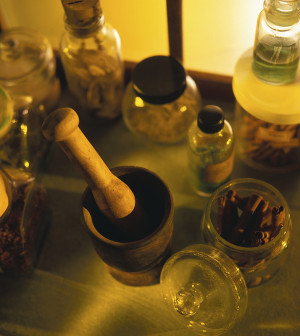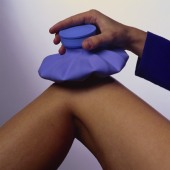- Navigating Your Midlife Crisis: Embracing New Possibilities
- City Raccoons Showing Signs of Domestication
- Mapping the Exposome: Science Broadens Focus to Environmental Disease Triggers
- One Week Less on Social Media Linked to Better Mental Health
- Your Brain Changes in Stages as You Age, Study Finds
- Some Suicide Victims Show No Typical Warning Signs, Study Finds
- ByHeart Formula Faces Lawsuits After Babies Sickened With Botulism
- Switch to Vegan Diet Could Cut Your Greenhouse Gas Emissions in Half
- Regular Bedtime Does Wonders for Blood Pressure
- Dining Alone Could Mean Worse Nutrition for Seniors
Acupuncture May Not Help Chronic Knee Pain, Study Finds


Acupuncture doesn’t improve knee pain any more than “sham” acupuncture, according to a new study.
“Among patients older than 50 years with moderate to severe chronic knee pain, neither laser nor needle acupuncture conferred benefit over sham for pain or function,” the study authors wrote. “Our findings do not support acupuncture for these patients.”
Sham acupuncture is any form of fake acupuncture, used so that researchers can test whether benefits from the traditional acupuncture may be due to a placebo effect. A placebo effect means a person believes his symptoms have improved despite receiving a fake medication or treatment.
“Subjective measurements such as pain are particularly subject to placebo responses,” said study co-author Kim Bennell, a professor of physiotherapy at the University of Melbourne in Australia. “This can be attributed to factors such as the treatment setting, patient expectations and optimism, the physician’s confidence in the treatment, and how the physician and patient interact.”
In this study, almost 300 adults with chronic knee pain received either needle acupuncture, laser acupuncture (hitting acupuncture spots with a low-intensity laser beam), sham laser acupuncture, or no treatment at all (the “control” group). With the sham treatment, a machine was pre-programmed not to deliver the laser, so neither the patient nor the acupuncturist knew it was a fake treatment.
Participants received 20-minute sessions up to twice a week for three months. They filled out questionnaires about their knee pain at the start of the study, three months later and one year later.
After three months, participants receiving needle, laser and sham acupuncture all experienced similar reductions in knee pain while walking, compared to the control group. The pain improvement was gone at a year, however, and the short-term improvements were too small to make a significant difference in practice, the authors wrote.
And, neither needle acupuncture nor laser acupuncture provided significantly greater relief than sham laser acupuncture, according to the study.
The patients who received needle acupuncture also experienced slightly improved physical function in their knees after three months compared to the control group, but it did not last a year, and a similar improvement was also seen in the sham group.
The findings were published in the Oct. 1 issue of the Journal of the American Medical Association.
This study was small, but its findings are similar to those of other acupuncture studies, according to Dr. Steven Novella, an assistant professor of neurology at Yale University School of Medicine. He said he was a little surprised that the difference between the treatment and control groups was not larger due to placebo effects.
“There are individual studies with weakly positive effects, but systematic reviews generally either show no effect at all or a slight effect that is not clinically significant,” Novella said.
The lack of long-lasting pain relief from acupuncture in this study could be due to other reasons though, said Jean-Paul Thuot, an acupuncturist and owner of Stillpoint Community Acupuncture in Victoria, British Columbia in Canada.
“Osteoarthritis can often cause changes to the bone or joint structure,” Thuot said. “If there are longstanding chronic changes to the structure, acupuncture will have a limited effect over such a short duration.” Most of the people included in this trial had symptoms that could have been caused by osteoarthritis, according to the study.
He added that the acupuncture was also not provided often or long enough to see an effect.
“Once or twice a week for eight to 12 weeks would, in my experience, hardly scratch the surface of such a condition, so I am not surprised that there was little change,” Thuot said. “With acupuncture there are so many variables from patient to patient that with the relatively small sample sizes often used in studies such as these, it would be difficult to come to any real conclusion as to the efficacy of the treatment.”
No serious side effects occurred in this study. Because acupuncture is invasive, Novella said side effects such as bleeding and infection can occur with needle acupuncture.
“There is also indirect harm of wasted resources and perhaps delaying more effective treatment,” Novella said. “Also, if a patient is convinced by placebo effects that acupuncture works, they may seek it out for a non-self-limiting illness, and there are ‘medical acupuncturists’ who will use acupuncture to treat anything, even cancer.”
The study was funded by the National Health and Medical Research Council in Australia.
More information
Find out more about knee pain at the U.S. National Library of Medicine.
Source: HealthDay
Copyright © 2025 HealthDay. All rights reserved.










